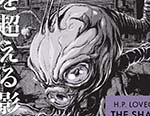 That striking sentence-long title is literal. BOOM! Studios’ creator-owned We Only Find Them When They’re Dead features 24th century humanity’s encounters with city-sized intergalactic Gods, who are always dead on arrival. Humans will not be saved by the heavens. Or at least, not like we thought. Rather than seek inspiration or providence from this floating divine detritus, we scavenge and strip-mine the corpses for resources, cutting out their “flesh” and extracting their eyes’ petroleum jelly to keep the species going, while the “autopsy ships” are monitored by tightly-regulated corporate “escorts.” Writer Al Ewing – making waves at Marvel Comics with Immortal Hulk and Guardians of the Galaxy – draws upon eclectic references like Alien, Moby Dick and Jack Kirby for a boldly original premise of humanity’s literal contact with religion. Although the expansive potential of the sentence-long We Only Find Them When They’re Dead makes the actual story come up short and narrow.
That striking sentence-long title is literal. BOOM! Studios’ creator-owned We Only Find Them When They’re Dead features 24th century humanity’s encounters with city-sized intergalactic Gods, who are always dead on arrival. Humans will not be saved by the heavens. Or at least, not like we thought. Rather than seek inspiration or providence from this floating divine detritus, we scavenge and strip-mine the corpses for resources, cutting out their “flesh” and extracting their eyes’ petroleum jelly to keep the species going, while the “autopsy ships” are monitored by tightly-regulated corporate “escorts.” Writer Al Ewing – making waves at Marvel Comics with Immortal Hulk and Guardians of the Galaxy – draws upon eclectic references like Alien, Moby Dick and Jack Kirby for a boldly original premise of humanity’s literal contact with religion. Although the expansive potential of the sentence-long We Only Find Them When They’re Dead makes the actual story come up short and narrow.
Scale is central to When They’re Dead. Ewing commands a Biblically epic tone, terse third-person narration surveying the autopsy crews, and decreeing of one ship – newly destroyed for “stealing” resources from the escorts – “The ship was the Pavonis Freedom. Now it is nothing.” The book’s dialogue contains suitable technobabble that gives grounded tension to the spaceship’s operation, but adds chiming rhythmic mantras (counting the beeps, the crew recite “eight bells, all’s well”) which adds a baroque, poetic flourish. As it is with Captain Georges Malik of the Vihaan II, who wishes to break away from the depressing routine of cutting up celestial corpses and squabbling over limited resources, and journey into unknown space to find a God. An alive one.
Malik’s desire to touch the divine, instead of its shell, veers between nihilistic discontentment with the current universe (and his tragic past) and desperate optimism that the edges of the cosmos will contain the existential fulfilment he seeks. For all of Malik’s brooding, there’s a dwindling believer in him, which Ewing makes an interesting character-study. When They’re Dead works best when attuned to this galactic perspective, particularly in breath-taking splash-pages from Simone Di Meo that convey the enormity of the Gods, the artwork conveying their grandiosity and incomprehensible significance.
Troubles arise in When They’re Dead, however, when the rest of the comic feels cramped. Much of it contains the Vihaan II crew confined to their respective ship quarters, not allowing for much unique interplay between the 4 members. Therefore, Malik’s supporting crew struggle to define themselves, visually or emotionally, muting the human component of When They’re Dead. Vihaan II’s quartermaster Alice, despite being told as having a deep background connection to Malik, especially comes across as simplistic and hollow.
Likewise, while Di Meo is fantastic at the cosmic immensity of space and the kinetic intensity of spaceship travels, the human side is lacking something. Di Meo’s figures are solid and believable and by no means bad, but the expressions are somewhat stiff and unchanging, and that makes them harder to connect with. This isn’t helped by the artwork being intentionally blurred and distorted by space-travel, which evokes the feeling of sci-fi but makes readers feel as if they’re outside the spaceship, looking in.
When They’re Dead struggles to sell the small alongside the large, including the plot itself being thinner than its implications, as Malik’s quest and subsequent pursuit by vengeful “escort” Paula Richter is drawn out and decompressed across the entire 5-chapter volume without much development.
These critiques may seem harsh, but they come from a place of admiration. Ewing has successfully weaved an ambitious story in Immortal Hulk, and We Only Find Them When They’re Dead is a creator-owned opportunity to dive into similar cosmically-religious territory. Frustrations arise with When They’re Dead from how competent the creative team are, and how well they create its foundations. Ewing particularly manages to throw readers into this intriguing premise without requiring dull expository introductions, and Di Meo’s view of space is truly compelling. So, When They’re Dead is disappointing only due to the exciting promise of the book, occasionally catching snippets of inspiration in a relatively straightforward intergalactic chase. We Only Find Them When They’re Dead has many fine qualities, with genuinely awe-inspiring artwork of the Gods, but this first volume feels like a morsel of a story, cut off from something much larger.
Al Ewing (W), Simone Di Meo (A), Mariasara Miotti (C Assists), AndWorld Design (L) • BOOM! Studios, $9.99
Review by Bruno Savill de Jong


















